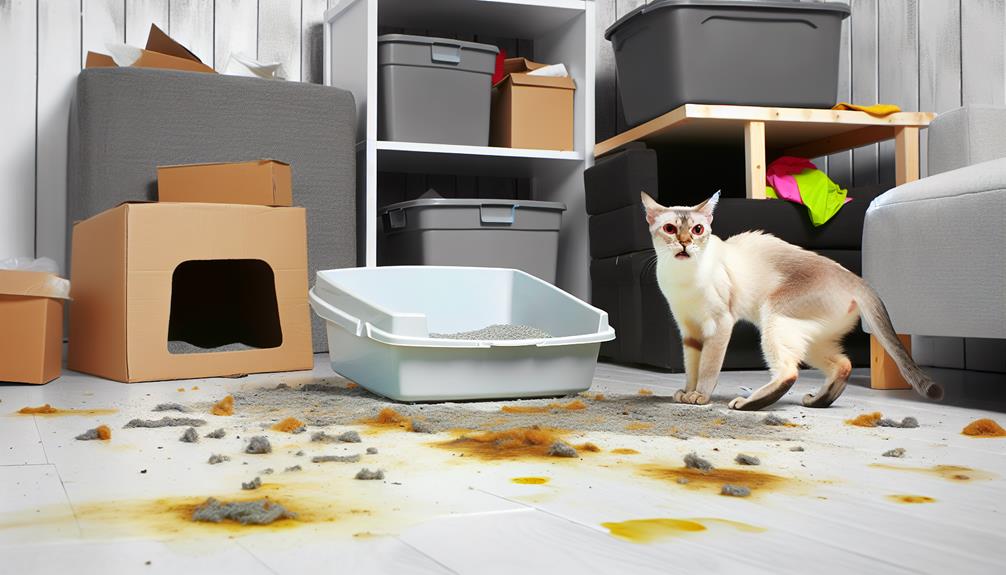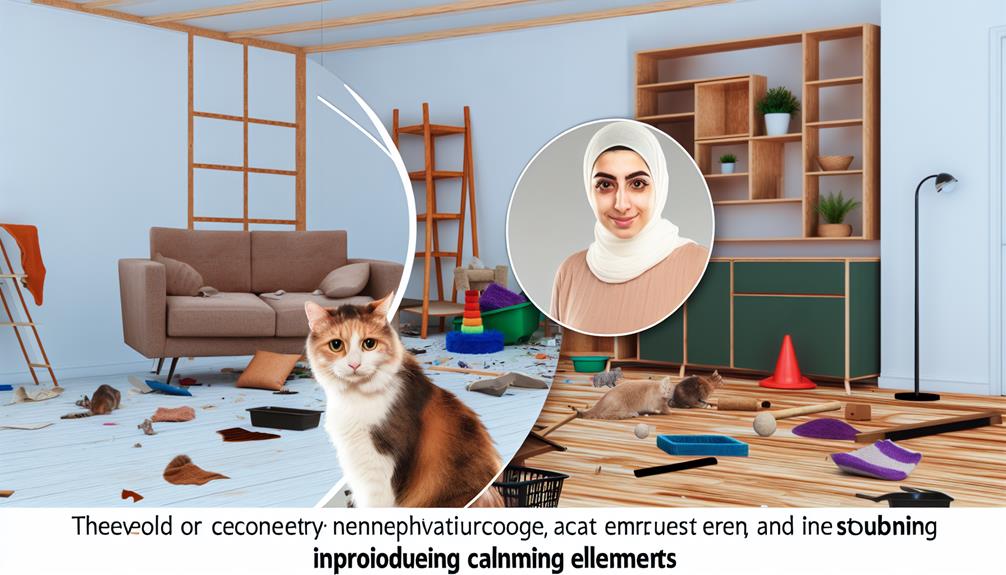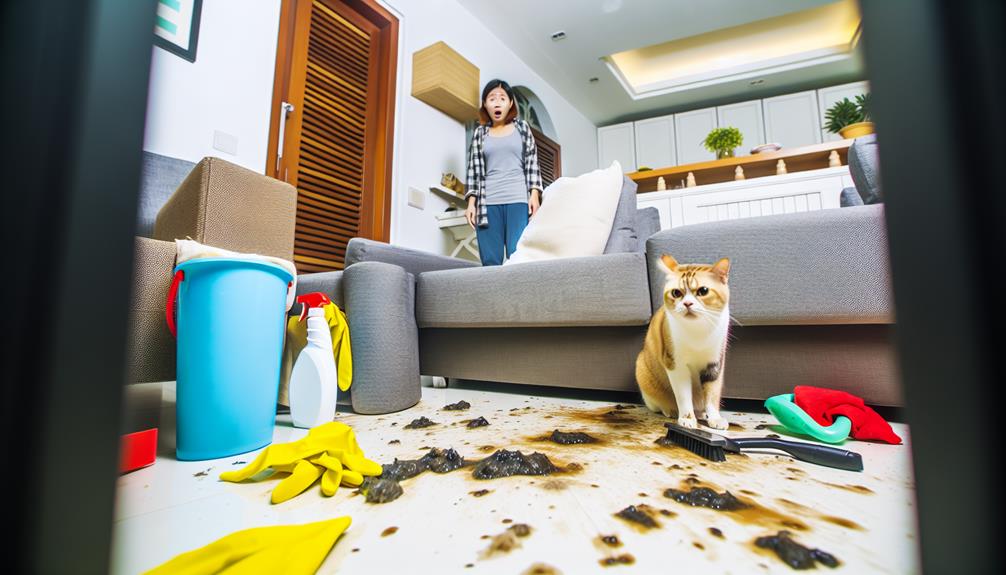If your cat is peeing everywhere, it could be due to stress, medical issues, or environmental changes. You might be wondering what's causing this disruptive behavior and how to tackle it. Is it a urinary tract infection, or perhaps something more subtle like anxiety? Maybe your cat's litter box isn't up to their standards. Understanding why your cat is avoiding their litter box is vital for both their well-being and your peace of mind. Let's explore the possible reasons and find solutions that work for both of you.
Medical Issues
A multitude of medical issues could be the underlying cause of your cat's inappropriate urination behavior. Among the most prevalent are conditions affecting the urinary tract, such as infections, inflammation, or even blockages. Urinary tract infections (UTIs) are a common culprit, causing your cat to experience discomfort and a frequent urge to urinate. You might notice blood in the urine or your cat straining to urinate, which are clear indicators of a UTI.
Kidney disease is another vital condition that can lead to inappropriate urination. As the kidneys lose their ability to filter waste effectively, your cat may start to drink more water and, consequently, urinate more frequently. This increased urination can sometimes occur outside the litter box if your cat can't make it in time. Chronic kidney disease often progresses slowly, so early detection through blood tests and urinalysis is essential for managing the condition and improving your cat's quality of life.
Additionally, you should consider the possibility of bladder stones or crystals, which can obstruct the urinary tract. These obstructions can cause severe pain and make urination difficult or impossible. In such cases, immediate veterinary intervention is necessary to prevent life-threatening complications.
Stress and Anxiety
Stress and anxiety can markedly impact your cat's urination habits, often leading to inappropriate elimination behaviors. Cats are creatures of habit and any disruption to their environment can be a significant stress trigger. You might notice changes in cat body language, such as excessive grooming, hiding, or vocalization, which are indicative of heightened stress levels.
Various factors can contribute to feline stress. Moving to a new home, introducing new pets or family members, changes in daily routines, or even alterations in the home environment, like new furniture, could be overwhelming for your cat. When your cat is stressed, their body may release stress hormones such as cortisol, which can exacerbate urinary issues, including inappropriate urination.
Understanding and identifying stress triggers is essential. Observe your cat closely for signs of anxiety. Behavioral changes can often be subtle; watch for changes in eating habits, litter box usage, and interaction levels. If your cat is urinating outside the litter box, it might be a coping mechanism to mark territory or seek comfort.
Addressing the root cause of stress involves creating a stable, predictable environment. Introduce changes slowly, provide hiding spaces, and promote interactive play to alleviate anxiety. Additionally, employing pheromone diffusers can help create a calming atmosphere.
Clinically, your veterinarian may recommend behavioral therapy or anti-anxiety medication for severe cases. Thorough management often requires a multi-faceted approach, combining environmental modifications with professional guidance.
Litter Box Problems

Litter box problems can be a significant factor contributing to your cat's inappropriate urination. One of the primary issues could be the type of litter you're using. Cats can be quite particular about their litter, preferring certain textures or scents. Clumping litter, for instance, is often favored because it allows for easier waste removal. However, some cats may have allergies or sensitivities to certain litter types, causing them to avoid the box altogether.
In addition to litter types, proper litter maintenance is essential. A dirty litter box can be a major deterrent for your cat. Cats are instinctively clean animals, and if their litter box is not maintained properly, they may seek out other, cleaner areas to relieve themselves. It's recommended to scoop out waste daily and completely change the litter at least once a week. Neglecting these tasks can lead to a buildup of ammonia and bacteria, further discouraging your cat from using the litter box.
The size and location of the litter box are also important considerations. A box that's too small may not provide enough space for your cat to comfortably turn around and dig. Similarly, placing the litter box in a high-traffic or noisy area can create stress for your cat, leading them to urinate elsewhere. Ensuring the box is in a quiet, accessible location can make a significant difference.
Territorial Marking
While litter box issues can often be resolved with adjustments, another common reason cats urinate outside their designated area is territorial marking. This form of urination is distinct from regular elimination and is deeply rooted in territorial behavior. Cats use scent marking as a method to communicate their presence and establish dominance within a given space. This behavior is particularly prevalent in multi-cat households, where social hierarchy is constantly being negotiated.
Territorial marking serves as a vital component of feline communication. When a cat spray-marks, they deposit small amounts of urine on vertical surfaces. This act not only conveys their presence but also communicates information about their reproductive status and individual identity to other cats. Dominance displays through scent marking can mitigate confrontations by establishing clear territorial boundaries, reducing the need for physical altercations.
Environmental factors play a significant role in triggering territorial marking. Changes such as the introduction of a new pet, alterations in household dynamics, or even the presence of stray cats outside the home can prompt a cat to mark its territory. These disruptions can create stress, compelling the cat to reinforce its dominance and secure its environment through urine marking.
Understanding the underlying motivations for territorial marking is essential for effective intervention. It's important to address both the behavioral and environmental factors contributing to this issue. Strategies such as spaying or neutering, providing sufficient resources (like litter boxes and scratching posts), and using synthetic feline pheromones can help reduce territorial marking. Additionally, consulting with a veterinarian or a feline behaviorist can provide tailored solutions to address your cat's specific situation.
Changes in Environment

Environmental changes, such as moving to a new home or alterations in routine, can greatly stress your cat, leading to inappropriate urination. Cats are creatures of habit, and disruptions can cause anxiety, manifesting as unwanted behaviors. Identifying and mitigating these stressors is essential for resolving the issue.
New Home Adjustments
Adjusting to a new home can be a significant source of stress for your cat, often resulting in inappropriate urination. When introduced to a new environment, new scents can be overwhelming. Your cat needs time to familiarize themselves with the furniture arrangement and to begin space exploration. Ensuring they find hidden places where they can retreat is essential for establishing safe zones. These safe zones help define their territorial boundaries, reducing stress and the likelihood of urine marking.
Vertical spaces, such as shelves or cat trees, provide additional opportunities for sensory stimulation and give your cat a sense of control over their environment. Setting up designated play areas can further enhance their comfort and reduce stress-induced behaviors like inappropriate urination.
During the adjustment period, monitor your cat's behavior closely. Look for signs that they are becoming more comfortable, such as relaxed body language and consistent use of the litter box. By facilitating a smooth changeover through careful consideration of these factors, you can mitigate the stress associated with a new home and help prevent inappropriate urination. Remember, patience and gradual acclimatization are key to a successful adjustment.
Altered Routine Stress
Changes in routine can throw your cat off balance, leading to stress-induced behaviors like inappropriate urination. When a cat's established routine is disrupted, it can result in heightened anxiety and stress. Routine changes, such as alterations in feeding times, sudden environmental shifts, or modifications in daily interactions, can greatly impact cat behavior. Cats are creatures of habit, and their psychological well-being heavily relies on predictable patterns.
Stress from routine changes can manifest in various ways, including urinating outside the litter box. This behavior is often a coping mechanism, as the familiar scent of their urine offers a semblance of comfort in an unsettled environment. Additionally, the presence of new objects, sounds, or people can exacerbate this stress, leading to a breakdown in previously reliable litter box habits.
To mitigate stress, gradually introduce any changes to your cat's routine. Maintain consistency in feeding schedules and guarantee their environment remains as stable as possible. Engage in regular play and interaction to provide emotional reassurance. Monitoring your cat's behavior closely during these changes can help identify stress triggers early and allow for prompt intervention, thereby minimizing stress-induced urination issues.
Aging and Health
As cats age, their health can take a toll, leading to various physiological and behavioral changes, including inappropriate urination. It's vital to understand that senior cats are more susceptible to age-related conditions that can affect their urinary habits. Conditions such as chronic kidney disease, diabetes mellitus, and urinary tract infections (UTIs) are particularly prevalent in older cats and can lead to increased urination or inappropriate elimination behaviors.
In senior cat care, regular health monitoring is essential to catch these conditions early. Routine veterinary check-ups, blood work, and urinalysis can help detect underlying health issues before they become severe. For example, chronic kidney disease often manifests in older cats and can lead to increased thirst and urination. A diabetic cat may also present with polyuria (excessive urination) and polydipsia (excessive thirst), further complicating their urinary habits.
In addition to these conditions, arthritis can make it difficult for a senior cat to access their litter box, leading to accidents outside the box. In this case, modifying the litter box environment can be beneficial. Lowering the sides of the box or providing multiple accessible boxes can make a significant difference.
Moreover, cognitive dysfunction syndrome (CDS) in older cats can also contribute to inappropriate urination. This condition is akin to dementia in humans and can cause confusion and disorientation, leading to accidents.
Behavioral Solutions

Addressing your cat's inappropriate elimination involves evaluating litter box preferences, establishing routine and consistency, and implementing stress reduction techniques. You'll need to assess the type, location, and cleanliness of the litter box to guarantee it meets your cat's needs. Additionally, maintaining a consistent daily routine and providing a stress-free environment can greatly mitigate behavioral issues.
Litter Box Preferences
A cat's litter box preferences are vital to understanding and resolving inappropriate urination behaviors. You need to evaluate various factors that influence your cat's litter box habits. First, consider the litter box materials; some cats prefer clumping clay, while others may favor silica gel or biodegradable options. It's important to experiment to determine what your cat prefers.
Next, assess the litter box size. A larger litter box provides more space for movement, which can be particularly beneficial for larger breeds or multi-cat households. The litter box location also plays a notable role. Cats typically prefer a quiet, easily accessible area, away from high-traffic zones.
Litter box cleanliness is another key factor. Regular cleaning is critical to prevent aversion. Scoop out waste daily and conduct thorough cleanings weekly to maintain hygiene. Furthermore, consistent litter box training from a young age can establish good habits.
You should also consider the variety of litter box types available. Covered boxes offer privacy but may trap odors, while open boxes provide better ventilation. Finally, guarantee litter box accessibility, especially for older or disabled cats, by providing low-entry options or ramps. Addressing these aspects thoroughly can greatly mitigate inappropriate urination.
Routine and Consistency
Establishing a consistent routine is pivotal for addressing inappropriate urination in cats. Cats are creatures of habit, and disruptions in their daily schedule can lead to stress-induced behaviors, including urination outside the litter box. To mitigate this, make sure you maintain regular feeding times, play sessions, and litter box cleaning. Consistency in these areas helps reinforce positive cat habits and reduces anxiety.
Analyzing your cat's daily schedule is essential. For instance, feed your cat at the same times each day to create predictability. Similarly, schedule interactive play sessions to expend your cat's energy and reduce stress levels. Regularly cleaned litter boxes also play a critical role; a dirty box can deter your cat from using it, leading to inappropriate elimination.
Furthermore, maintain a stable environment by minimizing changes in household routines. Sudden alterations can disrupt your cat's sense of security, exacerbating urination issues. By adhering to a structured routine, you create a sense of normalcy that can alleviate behavioral problems. Consequently, incorporating these strategies into your cat's daily schedule fosters a stable and predictable environment, ultimately addressing and preventing inappropriate urination behaviors.
Stress Reduction Techniques
When it comes to mitigating stress-induced urination in cats, behavioral solutions can be highly effective. One of the primary strategies involves creating calming environments. This means providing a safe space where your cat can retreat when feeling overwhelmed. Consider using pheromone diffusers, which release synthetic versions of feline facial pheromones to promote a sense of security. Additionally, guarantee that your home has multiple, easily accessible litter boxes located in low-traffic areas to minimize stress.
Mindfulness practices can also play a critical role in reducing feline anxiety. Engage in regular, gentle play sessions with your cat to help release pent-up energy and stimulate mental well-being. Interactive toys and puzzle feeders can be beneficial, as they provide both mental and physical stimulation. Moreover, maintaining a consistent daily routine for feeding, playtime, and grooming can help your cat feel more secure.
Implementing these techniques requires careful observation and adjustments based on your cat's specific needs. Monitor behavioral changes and be prepared to consult a veterinarian if stress-induced urination persists. A multi-faceted approach combining calming environments and mindfulness practices can greatly mitigate stress and reduce inappropriate urination behaviors in cats.
Conclusion
When your cat pees everywhere, remember the adage, "An ounce of prevention is worth a pound of cure." Identifying the root cause—whether it's medical, stress-related, or due to litter box issues—is essential. Consult with your veterinarian to rule out health problems and consider behavioral solutions. Addressing environmental changes, providing a stress-free setting, and guaranteeing a clean, accessible litter box can make a world of difference. Taking a proactive approach secures your feline friend's well-being.
